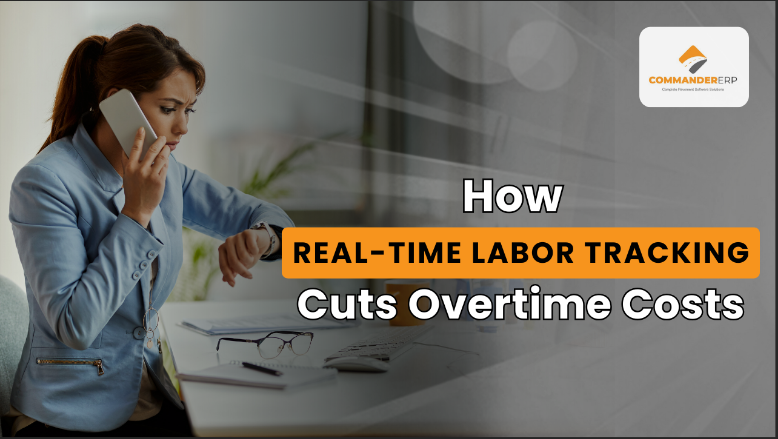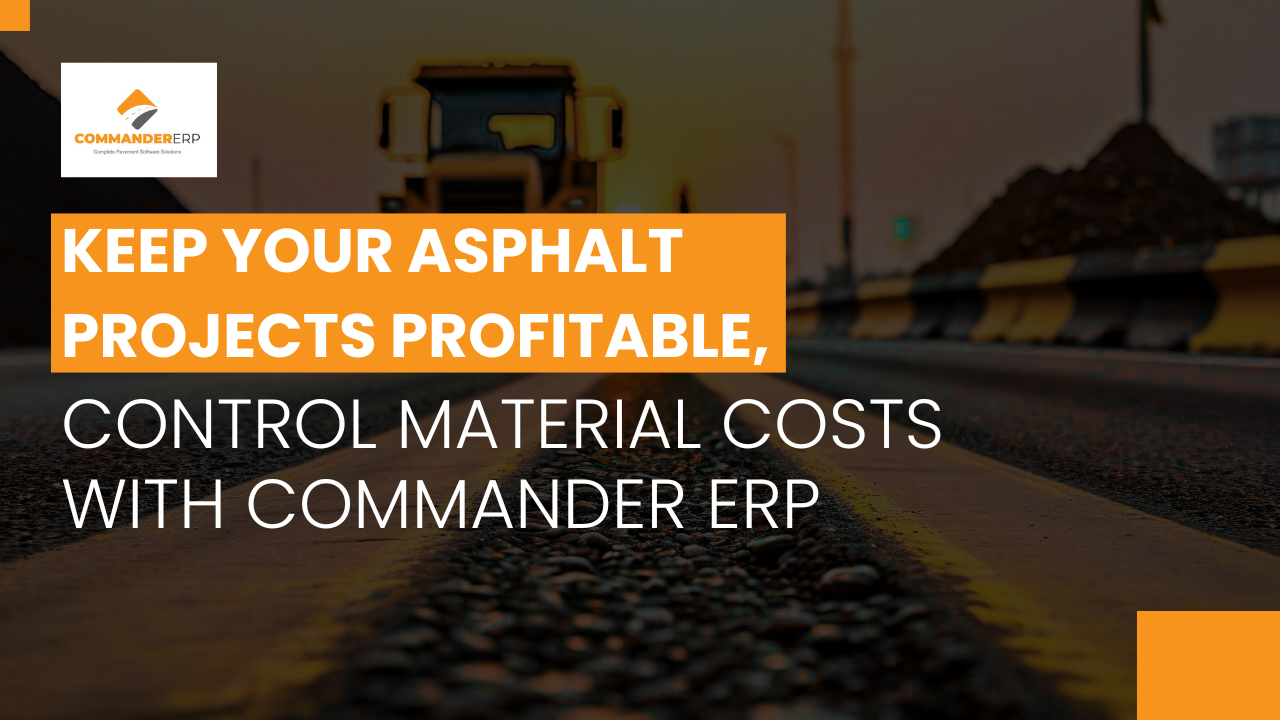
x
c
o
m
m
a
n
d
e
r
e
r
p
Blog
- Home
- Blog
- Commander ERP
- 2025-08-29
Keep Your Asphalt Projects Profitable, Control Material Costs with Commander ERP
Material costs are among the largest and most unpredictable expenses in the paving and construction industry. Asphalt, gravel, aggregates, and fuel can fluctuate daily, making it difficult for contractors to control budgets with confidence.
Many contractors only discover they’ve overspent after the project is completed, when the financial damage has already been done.
Imagine spending weeks working hard on a project, only to realize at the end that material overruns have eaten into your profit margins. For many paving and asphalt contractors, this is an all-too-common story.
It isn’t because they lack skill or experience; it’s because they lack real-time visibility into how materials are being used compared to what was budgeted.
The good news? Overpaying for materials doesn’t have to be the norm. With the right systems in place, contractors can spot potential overruns early, take corrective action, and keep their projects financially healthy.
Why Contractors Overpay for Materials
Contractors rarely intend to overspend, but without the right tools, it happens almost inevitably. Some of the key reasons include:
Lack of real-time tracking
Many contractors order materials in bulk and distribute them across multiple jobs. Without a system to track actual usage in real time, it’s easy to order more than necessary or fail to notice waste until it’s too late.
Reliance on spreadsheets and manual methods
While spreadsheets are useful for basic record-keeping, they don’t update automatically, nor do they alert you when usage exceeds your budget. Manual data entry is prone to errors, omissions, and delays that distort the real financial picture.
Price fluctuations in asphalt and fuel
Asphalt and fuel prices are particularly volatile, and using outdated estimates during bidding or project execution creates gaps between projected and actual costs.
Hidden losses like wastage, theft, or double ordering
Even a few tons of wasted asphalt or gravel can make a significant dent in profitability. Without a tracking mechanism, these small leaks often go unnoticed until the project is reconciled.
When combined, these factors create a situation where contractors think they’re staying within budget, but in reality, costs are silently rising behind the scenes.
The Impact of Material Over runs on Profitability
At first glance, a small overage may not seem like a big deal. But in paving projects where margins are already tight, those overruns add up quickly. Consider these consequences:
Eroded profit margins
Even a 5% overrun in asphalt usage can translate into thousands of dollars lost on a single project. Multiply that across a season, and contractors could lose the equivalent of an entire project’s profit.
Inaccurate job costing
When actual material usage isn’t properly recorded, future estimates are built on faulty data. This creates a cycle of inaccurate bids and inconsistent results.
Competitive disadvantage
Contractors with inflated cost assumptions often submit higher bids, pricing themselves out of jobs. On the other hand, underbidding without accurate tracking can result in winning the project but losing money.
Cash flow challenges
Material overruns often require contractors to dip into reserves or delay payments elsewhere. This can strain relationships with suppliers and make it harder to scale the business.
In short, material overruns don’t just affect one job, they ripple across the company, weakening both short-term and long-term profitability.
Why Tracking Usage vs. Budget Is the Key
The most effective way to prevent overruns is to track material usage against budget as the project happens, not after it ends. Contractors who monitor usage in real time enjoy several advantages:
Early warnings
If material usage begins to outpace the budget, contractors can adjust immediately, whether that means reducing waste, renegotiating deliveries, or tightening crew processes.
Data-driven purchasing decisions
Accurate consumption data allows contractors to order the right amount of materials at the right time, minimizing storage costs and preventing overstocking.
Improved forecasting
By comparing planned vs. actual usage, contractors build a reliable dataset that strengthens future estimates and bids.
Accountability across crews
When everyone knows usage is being monitored, crews are more mindful of how materials are handled, reducing carelessness and waste.
Tracking usage vs. budget transforms material management from guesswork into a disciplined, predictable process.
How Commander ERP Solves the Problem
This is exactly where Commander ERP makes a difference. Unlike spreadsheets or disconnected tools, Commander ERP provides real-time visibility into material usage and costs, all in one central platform.
Here’s how it works:
-
Automated tracking → Material usage is logged directly into the system, eliminating manual updates.
-
Budget comparison → Contractors can instantly see how actual usage stacks up against planned budgets.
-
Integration across operations → Material costs are linked with fuel, fleet, and labor data for a true picture of job costing.
-
Alerts and notifications → If usage exceeds thresholds, contractors receive early warnings so corrective action can be taken immediately.
-
Actionable reporting → At the end of the project, contractors can analyze trends, spot recurring issues, and adjust for future bids.
For example, one asphalt paving contractor using Commander ERP discovered they were consistently over-ordering gravel by nearly 10%. With real-time tracking and alerts, they corrected the issue within a single season and saved enough to reinvest in new equipment.
Beyond Cost Savings: Additional Benefits
While preventing overruns is the most obvious benefit, material tracking with Commander ERP delivers several additional advantages:
-
Sharper bids → With accurate usage history, contractors can bid with confidence, knowing their estimates reflect reality.
-
Stronger supplier relationships → Contractors with solid usage data can negotiate better terms and pricing with suppliers.
-
Enhanced crew accountability → When materials are tracked closely, crews become more efficient and responsible.
-
Client transparency → Municipalities and private clients appreciate contractors who can provide detailed, transparent usage reports.
This creates a virtuous cycle: better tracking leads to more accurate bidding, which leads to more wins, which leads to stronger profitability.
Conclusion
Overpaying for materials is one of the most common and most preventable challenges contractors face. By relying on guesswork, outdated spreadsheets, or delayed reporting, many paving businesses end up losing profits they didn’t even realize they were sacrificing.
But with the right tools, you can turn this around. Commander ERP empowers contractors to track material usage against budgets in real time, giving them complete control over costs.
Instead of waiting until the end of the project to discover overruns, contractors gain the visibility to act quickly, stay profitable, and strengthen their competitive edge.
Don’t let hidden material costs erode your margins. With Commander ERP, you can keep every project on track, every time.



